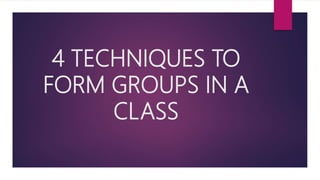4 techniques to form groups in a class
•Download as PPTX, PDF•
0 likes•59 views
Classrooms arrangements
Report
Share
Report
Share

Recommended
More Related Content
What's hot
What's hot (14)
Similar to 4 techniques to form groups in a class
Similar to 4 techniques to form groups in a class (20)
Simulated Activities for Teaching Listening, Speaking, Reading and Writing

Simulated Activities for Teaching Listening, Speaking, Reading and Writing
Lesson plan 4 práctica docente II - santiago cazenave

Lesson plan 4 práctica docente II - santiago cazenave
GuidedGuided ResponseIn addition to responding to your instru.docx

GuidedGuided ResponseIn addition to responding to your instru.docx
Recently uploaded
https://app.box.com/s/7hlvjxjalkrik7fb082xx3jk7xd7liz3TỔNG ÔN TẬP THI VÀO LỚP 10 MÔN TIẾNG ANH NĂM HỌC 2023 - 2024 CÓ ĐÁP ÁN (NGỮ Â...

TỔNG ÔN TẬP THI VÀO LỚP 10 MÔN TIẾNG ANH NĂM HỌC 2023 - 2024 CÓ ĐÁP ÁN (NGỮ Â...Nguyen Thanh Tu Collection
Recently uploaded (20)
ICT role in 21st century education and it's challenges.

ICT role in 21st century education and it's challenges.
Seal of Good Local Governance (SGLG) 2024Final.pptx

Seal of Good Local Governance (SGLG) 2024Final.pptx
On National Teacher Day, meet the 2024-25 Kenan Fellows

On National Teacher Day, meet the 2024-25 Kenan Fellows
TỔNG ÔN TẬP THI VÀO LỚP 10 MÔN TIẾNG ANH NĂM HỌC 2023 - 2024 CÓ ĐÁP ÁN (NGỮ Â...

TỔNG ÔN TẬP THI VÀO LỚP 10 MÔN TIẾNG ANH NĂM HỌC 2023 - 2024 CÓ ĐÁP ÁN (NGỮ Â...
Kodo Millet PPT made by Ghanshyam bairwa college of Agriculture kumher bhara...

Kodo Millet PPT made by Ghanshyam bairwa college of Agriculture kumher bhara...
Asian American Pacific Islander Month DDSD 2024.pptx

Asian American Pacific Islander Month DDSD 2024.pptx
This PowerPoint helps students to consider the concept of infinity.

This PowerPoint helps students to consider the concept of infinity.
Unit-V; Pricing (Pharma Marketing Management).pptx

Unit-V; Pricing (Pharma Marketing Management).pptx
Unit-IV; Professional Sales Representative (PSR).pptx

Unit-IV; Professional Sales Representative (PSR).pptx
ICT Role in 21st Century Education & its Challenges.pptx

ICT Role in 21st Century Education & its Challenges.pptx
Basic Civil Engineering first year Notes- Chapter 4 Building.pptx

Basic Civil Engineering first year Notes- Chapter 4 Building.pptx
4 techniques to form groups in a class
- 1. 4 TECHNIQUES TO FORM GROUPS IN A CLASS
- 2. TEAM COUNT INSTRUCTIONS Camera must be turn on Students must count from 1 to 10 but only one person may speak at a time Students who say the same number at the same time will form a group and the count must start again Why to choose it? Allow student to analyse the body language of their classmates in order to prevent from talking at the same time. Question can be made after the activity, this will help them to identify their own feelings. exm: What kind of thoughts or emotions did you have while the group was counting?
- 3. ANIMAL SOUNDS INSTRUCTIONS The teacher will give the name of an animal to each student , this animal makes an easily identifiable sound. For example, if there are nine people and you want to form groups of three, then you choose three animals. Teacher asks to students make the animal sound that was given to each one. Finally students will have to look for the same animal sound and they have to form a group. Why to choose it? Major interaction with their other partners . It is a funny way to divide the class in groups
- 4. MY FAVORITE MUSICAL GENRE INSTRUCTIONS: 1. Jamboard is divided into 3 musical genres: Pop, rock and salsa. 2. Teacher shares the jamboard link. 3. Students enter the link and choose a genre of their preference. 4. Don’t forget, only 3 people are allowed in each musical genre. Why to choose it? - Diversity of students when working in groups. - Avoid exclusion - Use digital resources to make the class more dynamic.
- 5. SCRAMBLED WORD INSTRUCTIONS Give your participants a list of five or six scrambled words (or more, based on how many groups you want to form) Ask the participants to unscramble as many words as they can on the list in three minutes Then form groups based on who unscrambled the same number of words (Group A unscrambled one word, Group B unscrambled two words, etc.) Why to choose it? Students will assess their vocabulary knowledge